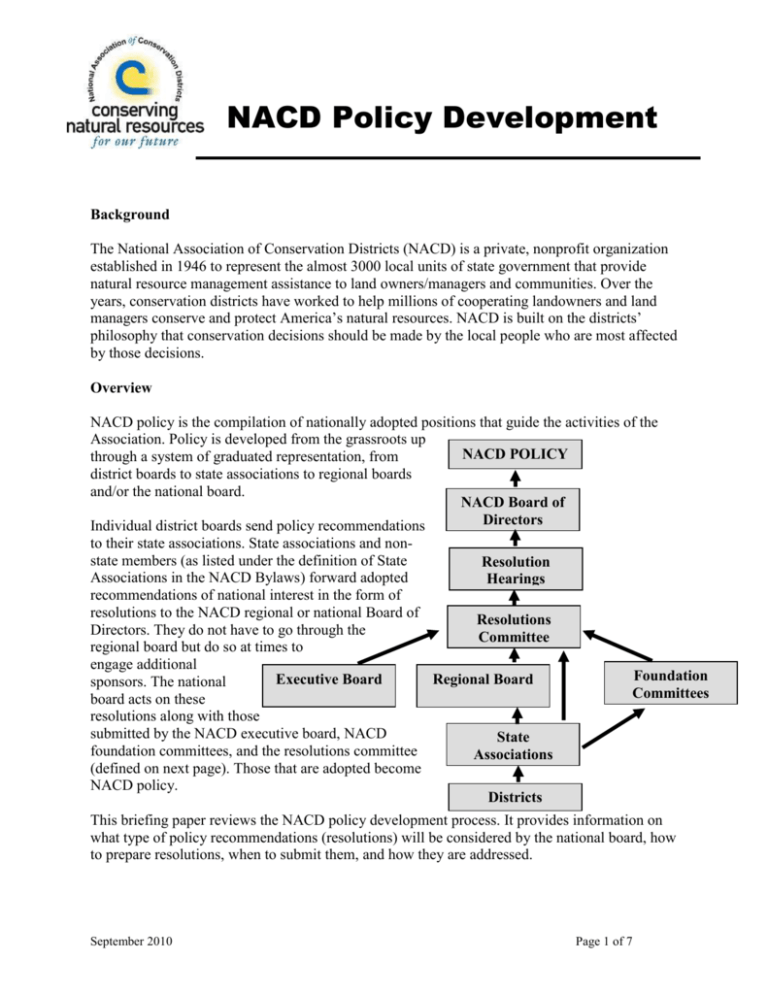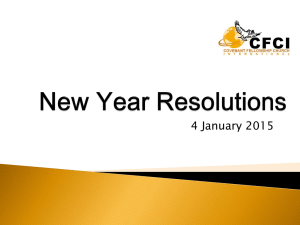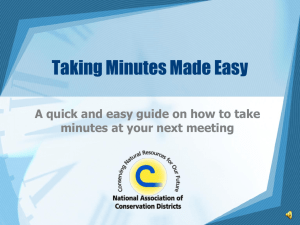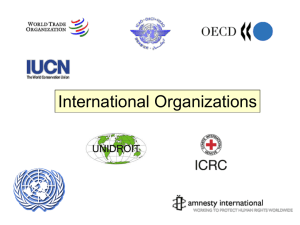NACD Policy Development Description
advertisement

NACD Policy Development Background The National Association of Conservation Districts (NACD) is a private, nonprofit organization established in 1946 to represent the almost 3000 local units of state government that provide natural resource management assistance to land owners/managers and communities. Over the years, conservation districts have worked to help millions of cooperating landowners and land managers conserve and protect America’s natural resources. NACD is built on the districts’ philosophy that conservation decisions should be made by the local people who are most affected by those decisions. Overview NACD policy is the compilation of nationally adopted positions that guide the activities of the Association. Policy is developed from the grassroots up NACD POLICY through a system of graduated representation, from district boards to state associations to regional boards and/or the national board. NACD Board of Directors Individual district boards send policy recommendations to their state associations. State associations and nonstate members (as listed under the definition of State Resolution to rs Associations in the NACD Bylaws) forward adopted Hearings recommendations of national interest in the form of resolutions to the NACD regional or national Board of Resolutions Directors. They do not have to go through the Committee regional board but do so at times to engage additional Foundation Executive Board Regional Board sponsors. The national Committees board acts on these resolutions along with those submitted by the NACD executive board, NACD State foundation committees, and the resolutions committee Associations (defined on next page). Those that are adopted become NACD policy. Districts This briefing paper reviews the NACD policy development process. It provides information on what type of policy recommendations (resolutions) will be considered by the national board, how to prepare resolutions, when to submit them, and how they are addressed. September 2010 Page 1 of 7 DEFINITIONS NACD Board of Directors – The Board of Directors consists of one voting representative from each state association of conservation districts and non-state members as listed in the NACD Bylaws, and the following nonvoting members: the five NACD officers, the immediate past president, one representative from each NACD geographic region, and one representative from the Conservation Technology Information Center. Each state association determines its method for selecting their representative and an alternate. NACD Regional Boards – The same state representatives on the NACD Board of Directors also serve on the NACD Regional Boards as designed by the geographical regions set in the NACD Bylaws: Northeast, Southeast, North Central, South Central, Northern Plains, Southwest, and Pacific. NACD Executive Board – The Executive Board consists of the President, First Vice President or President Elect, Second Vice President, Secretary-Treasurer, and one member from each of the NACD geographic regions. The Immediate Past President, the Chief Executive Officer, and one member from the Conservation Technology Information Center all serve as nonvoting members. NACD Foundation Committees – Foundation Committees are charged by the Board of Directors with exploring their functional area to formulate proposals for action and submit to the appropriate Officers and Official Bodies of the Association. These are usually submitted in the form of resolutions and/or reports. The committees are made up of NACD board members as appointed by the NACD President. The current Foundation Committees are: Communications; District Operations and Member Services; Legislative; Natural Resource Policy; and Stewardship and Education. NACD Resolutions Committee – The Resolutions Committee is appointed by the NACD President prior to the NACD Annual Meeting for the purpose of reviewing resolutions, the resolutions’ assignments to the consent calendar or hearings, and preparing resolutions if determined necessary. Membership usually includes an NACD Officer as Chair and chairs of the Foundation Committees. Resolutions Hearings – Formerly referred to as ‘Hearing Committees’, the Resolutions Hearings are conducted by the Foundation Committees. Held during the NACD Annual Meeting only, the purpose of the Hearing is to receive testimony and make recommendations on assigned resolutions for the full Board. September 2010 Page 2 of 7 PRIOR TO THE NACD ANNUAL MEETING Who May Submit Resolutions to the National Board Resolutions may be submitted, as adopted at their annual or special meeting, by state associations of conservation districts and non-state members as listed in the NACD Bylaws; NACD region boards; NACD foundation committees; the NACD executive board; and the NACD resolutions committee. Type of Resolutions for National Board For resolutions to be considered by the NACD Board of Directors, they must be concerned with the conservation, development or management of natural resources, or with the operations of districts; be of national or significant regional scope; and propose new policy, alteration of existing policy, or specific position statement for NACD. How to Prepare Resolutions for National Board Resolutions must be submitted in writing, in brief and concise form, without “whereas” and “therefore”; list the sponsoring entity(ies); present the problems or issues being addressed as background; state the specific position statement or action(s) and timing expected of NACD, note the date of the meeting where adopted, and be signed by an authorized member of the submitting entity. The brief background should include the impact on existing NACD policy; potential fiscal impact on NACD; potential outcome if the issue is not addressed, and if appropriate, potential fiscal impact on the federal budget. Resolutions that are inaccurate, non-germane, or are of concern only in an individual state, or in some instances region, will be returned to the submitting entity with a letter explaining the reason(s) for rejection. A decision to reject a resolution may be appealed to the Resolutions Committee. How To Submit Resolutions for the National Board State association presidents and executives, NACD Foundation Committee chairs, and Regional Board Chairs should submit proposed resolutions in writing to the NACD staff member designated by the NACD Chief Executive Officer (CEO) to coordinate the annual process. The September 2010 Page 3 of 7 preferred method is email, but all formats will be accepted if an authorized signature is provided. Contact information is provided on page 6. When To Submit Resolutions for the National Board Resolutions may be submitted anytime during the year, and sponsoring entities are encouraged to submit them as soon as possible after adoption. According to the NACD Bylaws, “resolutions should be received at least 30 days before the annual meeting”. Those submitted after the 30-day deadline will be presented to the Resolutions Committee as late resolutions to determine if and how they will be addressed at the annual meeting. NACD Handling of Resolutions Resolutions submitted to NACD will be edited by the CEO’s designee to ensure appropriateness for the national Board, clarity and grammatical uniformity. Resolutions that propose substantially similar policy will be combined. Any edits or combinations will be shared with the submitting entities for review and signature to the best extent possible. Each resolution will identify the submitting entity(ies). All resolutions will be assigned to a Board resolutions hearing or to the Consent Calendar, the latter of which contains those resolutions likely to be accepted with no debate and so can be adopted with one vote. Those resolutions received 30 days prior to the NACD Annual Meeting will be compiled into a preliminary resolutions pad. The draft pad, including the Consent Calendar and the hearing assignments, will be provided to the NACD Resolutions Committee in early January. The Committee will review the original resolutions, recommended edits and assignments, and will make changes as deemed appropriate. It will also review and assign all late resolutions. When approved by the Resolutions Committee and no later than 15 days prior to the NACD Board Meeting, the preliminary resolutions pad will be distributed to: voting members of the NACD Board of Directors and alternates; state association presidents and executives; NACD officers and executive board members; NACD staff; and other partners as appropriate. In addition, the CEO and policy staff will work with the NACD Legislative Committee to develop federal appropriations recommendations based on members' highest priorities. The recommendation will be reviewed by the Resolutions Committee prior to submitting it to the full Board for consideration. DURING THE NACD ANNUAL MEETING Saturday – Board of Directors Meeting The first meeting of the NACD Board of Directors is held on Saturday afternoon. Board members receive their meeting books, which contain the previously emailed resolutions and each board member’s assigned hearing. September 2010 Page 4 of 7 Saturday – Resolutions Committee Meeting The Resolutions Committee meets Saturday after the Board Meeting to review, and potentially assign, late resolutions. Sponsors of late resolutions are asked to attend and bring copies to this meeting for discussion. Sunday – Board of Directors Meeting Copies of late resolutions and any re-assignments are provided to the Board at the Sunday afternoon meeting. The updated resolutions pad and hearing assignments are also provided to non-board members as requested. Monday – Resolutions Hearings Every NACD Board member with his/her alternate is assigned to one of the resolutions hearings through their State’s assignment to a Foundation Committee. These hearings are conducted to allow NACD Board members to hear testimony, and then to debate and vote on the resolutions assigned to them. They are a vital step in the policy development process. The hearings provide for quality, informed discussion among a designated number of board members on most of the issues while reserving major policy concerns for the full Board action. Resolution hearing procedures are to follow Robert’s Rules of Order. After introducing a resolution assigned to the hearing, the chair calls on the sponsor of the resolution to explain and support it. In many cases, if the resolution sponsor or representative is not present to explain/defend a resolution that is not clear, it is rejected at the hearing. Just like in the Board of Directors meetings, each state has one vote even if both the member and alternate attend. Any district official in attendance may speak in support of or opposition to a resolution. As in NACD Board meetings, other attendees may also speak to resolutions to address technical clarifications and explanations and/or add factual information when requested by a Board Member or called upon by the presiding officer. They should speak neither in favor of, nor in opposition to, a resolution. The hearings’ actions on resolutions result in: those that are unanimously approved being added to the Consent Calendar; those that are approved, but not by unanimous vote, and those that are approved with amendment(s) being sent to the full Board to be voted on individually; or those that are defeated receiving no further action unless a two-thirds majority floor vote by the full Board brings it up for consideration. Tuesday Afternoon and Wednesday Morning – Board of Directors Meeting Full board meeting sessions are presided over by the NACD President or First Vice President/President-elect. All duly credentialed board members and alternate board members seated on the floor will have equal opportunity to be recognized by the chair. Only seated board members, or alternate in place of the board member, may vote on resolutions. The presiding officer will call on each resolutions hearing chair to give the report of the hearing and status of the resolutions considered. September 2010 Page 5 of 7 The procedure for these reports at the Board Meeting is: 1. Upon recognition by the presiding officer, the hearing chair shall announce each resolution and sponsor(s), present the hearing’s findings, speak to the resolution if not sent to the Consent Calendar by unanimous vote, explain any amendments adopted at the hearing, and call for technical clarifications, if necessary. 2. After announcement, the presiding officer shall call for a motion and second to adopt. 3. When duly moved and seconded, the presiding officer shall recognize the sponsor to speak to the resolution. The sponsor shall give a brief statement outlining the intent and meaning of the resolution. Discussion and debate may follow. The presiding officer shall follow normal rules of parliamentary procedure for handling amendments and the disposition of the motion. 4. Any tabled motions will die if not removed from the table prior to the conclusion of the final session of the Board of Directors meeting. The presiding officer will not, however, recognize a motion to table as being in order until the sponsor has moved the adoption of the resolution and been recognized for the purpose of explaining it. 5. In the case of late resolutions introduced from the floor and therefore not assigned to a resolutions hearing, the presiding officer will announce the resolution and then call for the Board to vote whether to address it through a two-thirds majority vote. 6. The Consent Calendar is considered in its entirety and is adopted or rejected by one vote of the full Board. Resolutions may be removed for floor debate by a two-thirds majority vote of the Board. 7. Resolutions defeated in the hearings may be brought to the floor for debate by a two-thirds majority vote of the Board. AFTER THE NACD BOARD MEETING All policy positions adopted by the NACD Board of Directors will remain in effect until their purposes have been accomplished, or until they are specifically altered or deleted. Tabling or rejecting a resolution containing partial existing policy does not affect the entire existing policy. The CEO will assign adopted resolutions requiring action to the appropriate NACD foundation committee, or other appropriate entity, for follow up. Each committee will develop, and with Executive Board approval, implement strategies to achieve the action(s). Adopted resolutions that state NACD positions on issues will be incorporated into policy statements developed by the NACD Legislative Committee in cooperation with the other NACD foundation committees. An action register of resolutions will be developed listing the resolution; the sponsoring entity; NACD Board action on the resolution; the committee and staff assigned take follow up action; and status of the action. This is used by the Board of Directors for reporting back to their states. CONTACT INFORMATION Doug Loudenslager, CEO, NACD 509 Capitol Ct NE, Washington DC 20002 202-547-6223 phone; 202-547-6450 fax doug-loudenslager@nacdnet.org September 2010 Debra A Bogar, Region Rep, NACD PO Box 621147, Littleton CO 80162-1147 303-988-1893 phone; 303-988-1896 fax deb-bogar@nacdnet.org Page 6 of 7 NACD POLICY DEVELOPMENT PROCESS TIMELINE FOR 2010 ANNUAL MEETING PRE-MEETING PREPARATIONS ACTION Email information packet on process to board members and alternates, state association presidents and execs, and others Send monthly reminder emails to board and state associations Submit resolutions throughout fall to NACD c/o Debra Bogar, and no later than Dec 30th (except states that meet in Jan) LEAD Bogar, DC Staff DEADLINE Sep Bogar Oct-Jan Dec 30 State Associations, NACD Committees, Region Boards (30 days stated in bylaws) Compile resolutions as received through Dec 30th; obtain board members’ names and contact info from all states Analyze resolutions impact on current policy and NACD resources. Notify Foundation Chairs of their responsibility to serve as Resolutions Hearings Chairs Assign resolutions to hearings; send draft resolutions packet to Resolutions Committee Review resolutions, assignments and impact on NACD via teleconference Bogar, Region Reps Sep-Dec Policy staff, Bogar Sep-Dec President Nov-Dec Bogar Jan 8 Resolutions Committee and staff advisors Jan 11 Revise resolution packet and assignments per Resolution Committee’s direction Send resolutions packet to board members, state associations and partners via email Brief board members and advisors on hearings’ assignments Include resolutions packet in Board notebooks Bogar Jan 13 Bogar, DC staff Jan 14 Committee Advisors DC Staff Jan Jan 15-20 LEAD Chair DEADLINE Jan 30 Ross, Duesterhaus Bogar Bogar Hearings’ Chairs NACD Board Jan 30 Jan 31-Feb 1 Feb 1 Feb 1 Feb 2-3 LEAD CEO or designee Comm Advisors DEADLINE Mar 15 Apr-Jul Bogar ongoing Region Reps Board Members Bogar Jun-Sep Jun-Dec Feb 2011 ONSITE ACTIVITIES ACTION Conduct Resolutions Committee meeting on needed actions, eg late resolutions, re-assignments, etc Brief new board members on process Make hearings’ information available to annual meeting attendees Brief full NACD Board on process Hold resolution hearings Act on resolutions POST MEETING FOLLOW-UP ACTION Assign resolutions for follow up action Have Executive Board and NACD foundation committees follow up on adopted resolutions Compile Executive Board and NACD foundation committees’ reports on resolutions’ actions Prepare status reports on resolutions for region boards Share status reports with state associations and districts Prepare status report for full Board September 2010 Page 7 of 7





